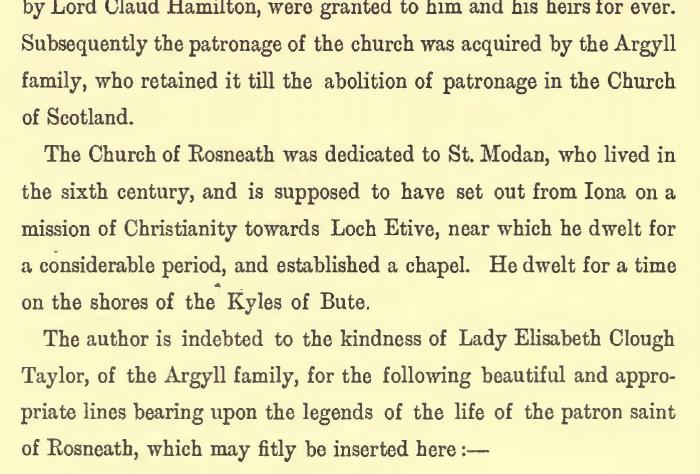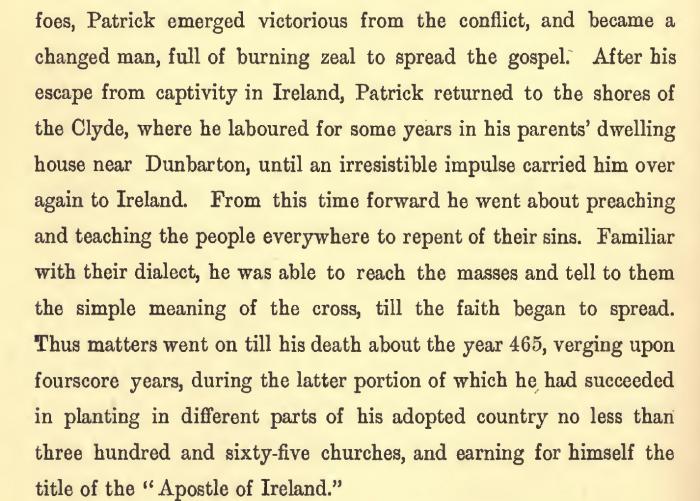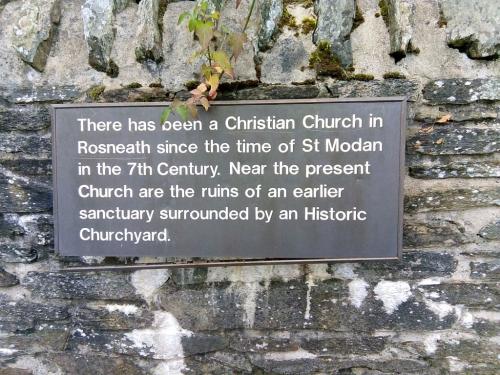|
AD
Allesley Park |
46 of 94
Fri 16th Oct 2020 5:27pm
It could also have been 'hedging their bets' and having vast wealth being able to contribute towards various institutions 'just in case'?
It could also be a political thing with Christianity becoming so popular so favouring that was a sign they felt that was going to be the future and to retain their position this was the best course of action.
For example, Emperor Constantine, who is pretty much responsible for the Bible as we know it, only became a Christian on his deathbed. There are other Christian converts who had pagan burials. |
| Coventry People - Lady Godiva | |
|
Earlsdon Kid
Argyll & Bute, Scotland |
47 of 94
Fri 16th Oct 2020 7:20pm
The arrival of Christianity in Britain seems to be quite early. The date AD597 appears in many articles I've seen, however there are some references to AD300's and even in AD156 during the time of Roman Emperor Marcus Aurelius Antoninus (AD121-180). Interesting! |
| Coventry People - Lady Godiva | |
|
Helen F
Warrington |
48 of 94
Sat 17th Oct 2020 12:36am
I think that everyone's a bit, if not wholly right about this. Godiva and Leofric were on the transition between two worlds both physically and spiritually.
The most likely possibility for Godiva's family is a brother called Thorold who was probably the sheriff of Lincoln. At her death she held lands near Newark and Lincoln, much of which was transferred to the Bishop of Lincoln after 1066. The area was well within the Dane Law. Might she have born into Viking religion? She was described as blond...
Godiva in the Domesday book.
The oldest church in Lincolnshire is believed to be Stow Minster "There had been a church in Stow even before the arrival of the Danes in 870, the year they are documented to have burnt the church down. The building remained in ruins until an abbey was built in 1040, reputedly by bishop Eadnoth II"
"It is said to have been re-founded and re-endowed in 1054 by Leofric and Godiva". The minster is dedicated to St Mary.
Leofric however came from outside the influence of the Vikings (by then) and was probably Christian from birth. His father was Earl of West Mercia which crucially included Evesham. Might he have grown up there rather than the bigger towns of Worcester or Gloucester?
Whether the couple's religious enthusiasm was a cynical ploy buying favour with the locals, influential people and god or they were truly devout we can never know but they did a good impression of piety (give or take a bit of war, destruction and victimisation). I've never been able to understand that of all the rules and regulations in religion that 'thou shalt not kill' is one that seems so flexible. |
| Coventry People - Lady Godiva | |
|
Kaga simpson
Peacehaven, East Sussex |
49 of 94
Sat 17th Oct 2020 12:00pm
Helen,
In a recent post I said this stuff has been around for ages, and you then told me to read articles. I did - 66 years ago. They haven't changed one word. There is no proof that either of them actually ever met a Roman.
The heart of Christianity - in 313AD the edict was between two Italian cities ordering their affairs, had nothing to do with England, and unlikely to be known for some years later.
A cluster of houses had sprung up in 'Leonine', the spiritual part of Rome, but it was late ninth century before the first walls of St Peter's were erected, and the 12th century before they had a roof of sorts.
Yet here in England, Godiva was building churches, throwing money around etc. two hundred years before.
Sometime around 1300 the Papal Court moved out of Rome to Avignon, the Popes returned near the end of the century. |
| Coventry People - Lady Godiva | |
|
Kaga simpson
Peacehaven, East Sussex |
50 of 94
Sat 17th Oct 2020 12:02pm
PS. Leonine was king of Greek Sparta. |
| Coventry People - Lady Godiva | |
|
Helen F
Warrington |
51 of 94
Sat 17th Oct 2020 1:45pm
I don't understand what you're trying to say Kaga. Why would Godiva or Leofric have had to have directly meet a Roman, by which I assume you mean someone who came from the centre of the Catholic church, to have become Christian and as it happens Catholic? Though they probably did meet representatives from the Pope. People travelled long distances, even then. In 1026 Cnut went to Rome as part of his repentance for his heathen ways and the damage his army had done to communities and religious houses. Godiva and Leofric would have travelled to London to see the kings on multiple occasions.
Just because Catholicism's architecture wasn't on the scale it is now, it doesn't mean that the power wasn't growing and felt as far as England. The church sent out missionaries to convert us heathens. There was a set back due to the Vikings but it slowly expanded its power over English minds and souls. Buildings were very modest to start. The earliest ones may have been wood but even a small stone building would have indicated it was more special than those around it. Godiva's St Mary's church was supposed to be no more than 100ft long, whereas the cathedral St Mary's was 425ft. The first St Mary was reputed to be 'richly' endowed but rich by our standards might be misleading. In terms of gold and silver the weight put together was very high but the styling would have been quite rough. There was a statue of St Mary about which Godiva had a necklace placed when she was dying but the appearance of the statue wouldn't have been a Renaissance masterpiece but a lot more like the Knave's Post. Her clothes may have been fabric and her face painted on or fashioned out of gold and silver. Nobody knows. Two items highly prised were the silver and bronze encased skull of St Osburg and the arm of St Augustine of Hippo (donated by Cnut), which were placed on a silver encrusted beam at the altar end of the church. The arm was reputed to have cost 100 talents of silver and one of gold. I'm not sure what weight a talent was at that point in time but in earlier times it was either 72lbs 3oz or the weight in silver that equalled a skilled worker's wages for 9 years. Robert De Limesey is said to have scraped 100 marks of silver from the beam those relics sat on. A mark being 8oz, makes that a total of 3.6 stone or 22.7kg. |
| Coventry People - Lady Godiva | |
|
Kaga simpson
Peacehaven, East Sussex |
52 of 94
Sat 17th Oct 2020 3:07pm
Helen,
What I'm saying, it was too early in Christian culture for Godiva to be involved with what you are trying to make them. I don't believe. If Rome couldn't do the things you say, then I'm sure Coventry could not. The Domesday Book wasn't around, no one really knows were St Augustine came from. Everything was a lot earlier than got printed, all this gold and silver you mentioned would have taken time collect. To me transport, word of mouth, all took a long time to elapse as the Vatican shows. You talk of a statue then say nobody knows, which is correct - nobody knows, so why mention it.
Helen, please don't take this as bad as it sounds, you do a fantastic job, and I thoroughly enjoy the difference of opinion, it actually keeps me going.
Do you know, I cannot find a painting by a top artist of St Augustine, but Michelangelo painted one of St Helen. |
| Coventry People - Lady Godiva | |
|
Helen F
Warrington |
53 of 94
Sat 17th Oct 2020 3:45pm
Glad to hear that you're boosted by the back and forth Kaga - you make me look stuff up and I find out things I've never thought about before.  |
| Coventry People - Lady Godiva | |
|
Earlsdon Kid
Argyll & Bute, Scotland |
54 of 94
Sat 17th Oct 2020 6:42pm
I've attached a couple of screengrabs from a book covering the area I live in just west of Helensburgh. Rosneath village has its church dedicated to St Modan who was reputedly a Christian missionary in 6th century Scotland. Incidentally, St Patrick was also possibly from nearby Dumbarton before reputedly establishing 365 church in Ireland before his death about 465AD.

 I realize this is not entirely Coventry related but it does help indicate the spread of Christianity throughout the British Isles!
I realize this is not entirely Coventry related but it does help indicate the spread of Christianity throughout the British Isles!
|
| Coventry People - Lady Godiva | |
|
mcsporran
Coventry & Cebu |
55 of 94
Sun 18th Oct 2020 8:03am
On 17th Oct 2020 3:45pm, Helen F said:
. . . Aurelius Augustinus Hipponensis; 13 November 354 - 28 August 430 AD also known as St Augustine of Hippo. . . .
Going right off topic here, but when I see ancient dates of this accuracy, I wonder how on earth they were calculated, I'm sure he doesn't have a birth or death certificate, nor an obituary at www.newspaperarchive.com! The concept of AD and the numbering of years in a single series wasn't introduced until a century after this by the monk Dionysius Exiguus (circa 470 - circa 544) and it was the Venerable Bede who made that system popular two centuries later still. Even England and Scotland couldn't agree on what year it was until 1752. Anyway St. Augustine died on a Saturday if this is a date in the modern Gregorian calendar, (introduced by the pope in 1582), or the previous day if this was the Julian calendar, current at that time. |
| Coventry People - Lady Godiva | |
|
Kaga simpson
Peacehaven, East Sussex |
56 of 94
Sun 18th Oct 2020 10:16am
Our memories are very short - something someone's told as a child gets scrambled as we grow older. We have a prime example on here in a topic. Look at the Domesday Book, and we see differences, most of these old dates were written centuries after. So what do we know of The Dead Sea Scrolls, have they not been hidden, are they not completely different from what we once knew?
Helen - no, we cannot rely on Rome buildings. I once heard a lady say, looking at the Colosseum, 'Oh it's a pity so much fell down'. It had been robbed of stone by another Emperor. They robbed Nero's stone to help build St Peter's church, in fact the church is built on most of his circus.
Back in Coventry, Saxon time and even in 1000AD, things wouldn't have been familiar. Buildings weren't laid out in streets, that didn't happen till after 1066 and the Normans. Stone walls were built about 3ft high then a large stone was laid across as a buttress. Mansions didn't appear till around late 900AD - there was, I believe, the oldest UK Saxon church in Northampton, but the tower wasn't fitted till centuries later. And perches were the measurement and I have forgotten what the distance was! |
| Coventry People - Lady Godiva | |
|
Annewiggy
Tamworth |
57 of 94
Sun 18th Oct 2020 10:49am
In the course of my research for family trees I have found that early records do not have a date but are just dated by the year of the reign of the current monarch eg 15E was 1287. Some of the dating can only be done if a person was listed as witnessing a certain document. Family trees are listed in old books on google books if the family had a coat of arms so that someone could prove their right to use it. Property was also listed through families to decide who had the right of ownership. It is quite interesting trying to work out when someone lived going back that far. Ancient documents are still being discovered which all add to our countries history. |
| Coventry People - Lady Godiva | |
|
Kaga simpson
Peacehaven, East Sussex |
58 of 94
Sun 18th Oct 2020 11:15am
Helen
I'm pretty sure that building was a pagan building at first, and paintings and writing came centuries later? |
| Coventry People - Lady Godiva | |
|
Kaga simpson
Peacehaven, East Sussex |
59 of 94
Sun 18th Oct 2020 11:19am
PS. Imagine trying to paint someone of six hundred years ago, that you had no photo to work from. |
| Coventry People - Lady Godiva | |
|
Earlsdon Kid
Argyll & Bute, Scotland |
60 of 94
Sun 18th Oct 2020 12:31pm
Following on from my post No.54 (yesterday) I walked past St Modan's Church this morning and photographed the plaque below the notice board.

|
| Coventry People - Lady Godiva | |
Website & counter by Rob Orland © 2024
Load time: 35ms